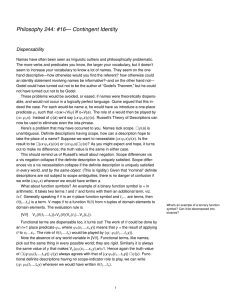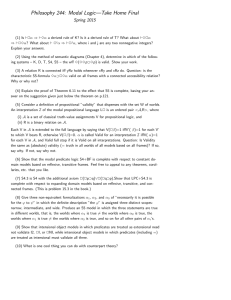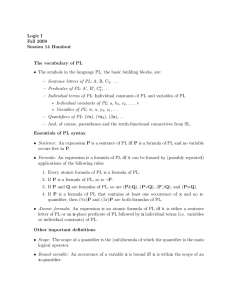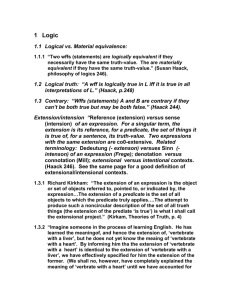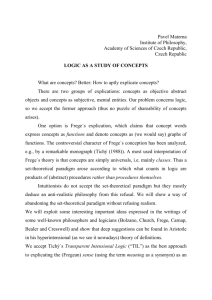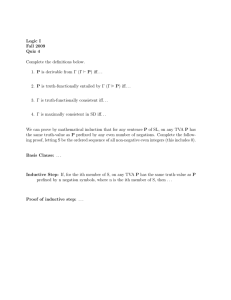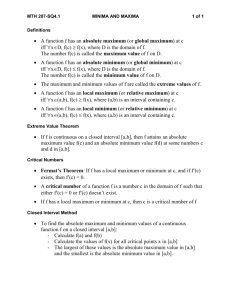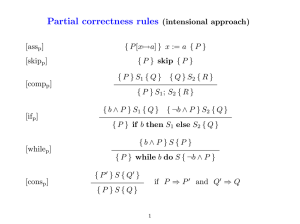Philosophy 244: #17—Intensional Objects Intensional Objects
advertisement
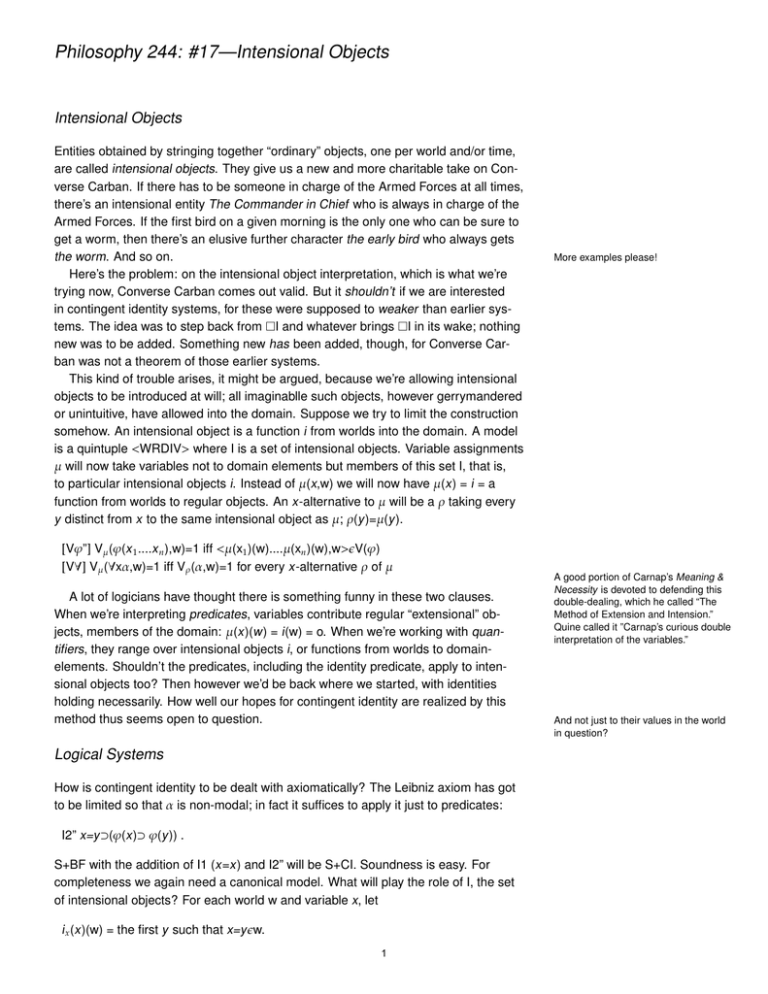
Philosophy 244: #17—Intensional Objects
Intensional Objects
Entities obtained by stringing together “ordinary” objects, one per world and/or time,
are called intensional objects. They give us a new and more charitable take on Converse Carban. If there has to be someone in charge of the Armed Forces at all times,
there’s an intensional entity The Commander in Chief who is always in charge of the
Armed Forces. If the first bird on a given morning is the only one who can be sure to
get a worm, then there’s an elusive further character the early bird who always gets
the worm. And so on.
Here’s the problem: on the intensional object interpretation, which is what we’re
trying now, Converse Carban comes out valid. But it shouldn’t if we are interested
in contingent identity systems, for these were supposed to weaker than earlier systems. The idea was to step back from I and whatever brings I in its wake; nothing
new was to be added. Something new has been added, though, for Converse Carban was not a theorem of those earlier systems.
This kind of trouble arises, it might be argued, because we’re allowing intensional
objects to be introduced at will; all imaginablle such objects, however gerrymandered
or unintuitive, have allowed into the domain. Suppose we try to limit the construction
somehow. An intensional object is a function i from worlds into the domain. A model
is a quintuple <WRDIV> where I is a set of intensional objects. Variable assignments
µ will now take variables not to domain elements but members of this set I, that is,
to particular intensional objects i. Instead of µ(x,w) we will now have µ(x) = i = a
function from worlds to regular objects. An x-alternative to µ will be a ρ taking every
y distinct from x to the same intensional object as µ; ρ(y)=µ(y).
[Vϕ”] Vµ (ϕ(x 1 ....x n ),w)=1 iff <µ(x1 )(w)....µ(xn )(w),w>V(ϕ)
[V∀] Vµ (∀xα,w)=1 iff Vρ (α,w)=1 for every x-alternative ρ of µ
A lot of logicians have thought there is something funny in these two clauses.
When we’re interpreting predicates, variables contribute regular “extensional” objects, members of the domain: µ(x)(w) = i(w) = o. When we’re working with quantifiers, they range over intensional objects i, or functions from worlds to domainelements. Shouldn’t the predicates, including the identity predicate, apply to intensional objects too? Then however we’d be back where we started, with identities
holding necessarily. How well our hopes for contingent identity are realized by this
method thus seems open to question.
Logical Systems
How is contingent identity to be dealt with axiomatically? The Leibniz axiom has got
to be limited so that α is non-modal; in fact it suffices to apply it just to predicates:
I2” x=y⊃(ϕ(x)⊃ ϕ(y)) .
S+BF with the addition of I1 (x=x) and I2” will be S+CI. Soundness is easy. For
completeness we again need a canonical model. What will play the role of I, the set
of intensional objects? For each world w and variable x, let
i x (x)(w) = the first y such that x=yw.
1
More examples please!
A good portion of Carnap’s Meaning &
Necessity is devoted to defending this
double-dealing, which he called “The
Method of Extension and Intension.”
Quine called it ”Carnap’s curious double
interpretation of the variables.”
And not just to their values in the world
in question?
I is the set of i x for each variable x, and the canonical assignment µ takes each x to
i x . As usual, <x 1 ....x n ,w>V(ϕ) iff ϕ(x 1 ...xn )w.
Prop. 18.1 Vµ (α,w)=1 iff αw.
Completeness follows as before. If α is S+CI-valid, then it holds in all worlds of all
models built on S-frames. If the canonical model is built on an S-frame, then α holds
in all worlds of the canonical model, that is, in all maximal S+CI-consistent sets. A
statement belonging to all maximal consistent S+CI-sets is a theorem. Hence every
valid α is a theorem, as promised.
There’s some flexibility in the amount of
contingent identity/distinctness allowed.
Say we want a semantics validating I
(x=y⊃x=y) but not necessarily NI
(x,y⊃x,y). Then we stipulate that
when wRu, if i 1 and i 2 agree on w, they
agree on u—while not stipulating that
when wRu, if i 1 and i 2 agree on u, they
agree on w.
Plenitude
If the intensional domain I consists of all intensional objects (all functions from W
into D) then the converse Carban formula ∃xϕx⊃∃xϕx becomes valid. It is not
any sort of contingent identity system we’re dealing with, in that case, because CI
systems are weaker than, say, S+BF+I+NI, and S+BF+I+NI doesn’t have
∃xϕx⊃∃xϕx as a theorem.
Fine, so they’re not contingent identity systems. The question stlll arises: is their
logic, the logic of ALL intensional objects, axiomatizable? The answer in a word is
NO, except under special conditions. Of the systems S we have considered, the logic
of IOs based on S is unaxiomatizable with the single exception of S=S5.
A definition. Given a class C of frames, α is ”C-valid for intensional objects” iff
Vµ (α,w)=1 for every wW in every intensional object model <WRDV> (I is omitted
since it’s predictable from the rest) based on a frame <WR>C. The claim is that
C-validity thus defined is not for the most part axiomatizable.
The method of proof is interesting. Remember second-order logic, the logic that
lets us quantify into predicate position? There’s a way to translate wffs of secondorder logic into wffs of modal predicate logic so that validity is preserved. This is
important because second-order logic is unaxiomatizable. If intensional modal logic
were axiomatizable, with no restriction on the intensions, this would enable an axiomatization of second-order logic via the translation. Ba-boom! Contradiction! So
the modal logic of all intensional objects is not axiomatizable.
The fragment L2 of 2nd order logic we need involves just (a) a bunch of one place
predicate variables ϕ, ψ, etc. and (b) a two-place predicate constant R. Just as the
term position in ϕx can be existentially generalized in 1st order logic to obtain ∃xϕx,
the predicate position can be generalized in 2nd order logic to obtain ∃2 ϕ ϕx. A
model for L2 is just like a model for first-order logic except that, now that we’re understanding ϕ, ψ, etc. as variables, their values are given by µ instead of V. For each
one-place ϕ, µ(ϕ)⊂D. R is the only predicate constant; its value V(R) in a model
<DV> is a subset of D×D. The only new semantical rule we will need is
[V∀2 ] Vµ (∀2 ϕ α)=1 iff Vρ (α) = 1 for every ϕ-alternative ρ of µ.
The next step is to reconceive the semantics of L2 so that it bears on modality.
The domain D of L2 is conceived as a set W of worlds. The interpretation function
V interprets R as the accessibility relation on D. To help us keep this in mind, we
refer to D as W, and to domain-elements as w. Since all that V does is identify the
accessibility relation R, a model for language L2 is not essentially different from a
frame for modal propositional logic. <D,V> ”=” <W,R>.
2
Until further notice, C-valid means
C-valid for intensional objects.
We’ll be working with just a fragment
of second-order logic, but it too is
unaxiomatizable.
Translation
Now we’re getting somewhere. Just as we imagine the domain of L2 as a set of
worlds, we can imagine the domain of our intensional object model as a set {0,1}
of truth-values. A subset A of W (from our second-order non-modal model) may be
coded by the intensional object i A taking w to 1 iff wA and 0 if w<A.
That’s the simple version anyway; it has to be complicated in two slightly mindbending ways. First, the truth-values associated with 1 and 0 will be allowed to flip
from world to world; 1 is sometimes truth and sometimes falsehood. Second, there
may be more objects in D than just {0,1}; it can be any set of objects as long as
they’re suitably subdivided into the ”true” and the ”false.” .
Every wff α of L2 is going to be translated into a wff τ(α) of a language L* of
modal predicate logic. L* has just a single one-place predicate T. T applies in a
world w to the domain elements that will count as ”true.” What it takes for a world w
to go into the set coded by i A is that i A (w)V(T,w), that is, i A takes w to the subset of
its domain that plays the ”true” role.
Now the translation; the individual variables of L* are assumed to include all those
of L2 plus an individual variable x ϕ for every predicate variable ϕ of L2 .
i A in the usual parlance is A’s characteristic function.
τ(ϕx) = ^(Tx&Tx ϕ )
τ(xRy) = ^(Tx&^Ty)
τ(¬α) = ¬τ(α)
τ(α∨β) = τ(α)∨τ(β)
τ(∀xα) = ∀xτ(α)
τ(∀2 ϕ α) = ∀x ϕ τ(α)
The atomic cases are the strangest. Think of the first like this. If x in L2 is assigned a world w, then x in L* is assigned an intensional object i that is ”true” (that
satisfies T) only in w. Likewise if ϕ in L2 is assigned a subset A of W, then x ϕ is assigned in L* an intensional object that is true (that satisfies T) in a world w iff wA.
Bearing all this in mind, when will ^(Tx&Tx ϕ ) be true? It will be true iff a world is
visible at which both Tx and Tx ϕ are true, iff a world is visible at which
(Tx) the world that µ assigned to x in L2 and
(Tx φ ) a member of the set of worlds that µ assigned to ϕ in L2 .
....iff Vµ (ϕx,x) = 1. Likewise, ^(Tx&^Ty) is true iff Tx and ^Ty are true at some
visible world, iff ^Ty is true at the world µ assigns to x in L2 , iff the world µ assigns
to x bears R to the world assigned to y, iff Vµ (xRy) = 1.
Testing
Suppose you are given a frame <WR> and an intensional objects model <WRDV*>
for L* based on <WR> in which, for every wW, there are <u,w>V*(T) and <v,w><V*(T),
that is, some domain elements are true and some false. µ for L2 and µ* for L* correspond iff for every wW and every variable x or ϕ of L2
(i) <µ*(x)(w),w>V*(T) iff w=µ(x)
(ii) <µ*(x ϕ )(w),w>V*(T) iff wµ(ϕ).
Where V is the valuation of L2 that maps the predicate R to the relation R of our
intensional objects model, and Vµ assigns to α the usual truth-value determined
according to the rules of 2nd-order logic,we have:
3
So the truth of ^(Tx&Tx ϕ ) in the modal
language goes with the truth of ϕx in the
second-order language, and the truth of
^(Tx&^Ty) goes with the truth of xRy.
Prop. 18.2: Suppose α is a wff of L2 , wW, wRµ(x) for every variable x, and µ and
µ* correspond. Then Vµ (α) = Vµ∗ *(τ(α),w).
Proof: See 338-340
Next we have to link up validity on a frame with validity in the corresponding intensional objects model. Define
Wx =df ^Tx&∀y((Tx⊃Ty)∨(Tx⊃¬Ty))
Lemma 18.3 Vµ∗ *(Wx,w*)=1 iff w* sees a w s.t. <µ*(x)(w’),w’>V*(T) iff w’=w.
For all w’.
This considered as a condition on µ* is just what it takes for µ* to correspond with
some µ, since we can just let µ(x) be the unique w such that <µ*(x)(w),w>V*(T).
Prop. 18.4 If α(x 1 -x n ) is an L2 wff, and α* = (∃xTx&∃x¬Tx)&Wx 1 &...Wx n )⊃τ(α),
then α is valid on <WR> iff α* is valid on every IO model based on <WR>.
Unaxiomatizability
Now we are almost there. For a system to be axiomatizable is for there to be an
effective means of enumerating its theorems. If IO systems were axiomatizable then
we could enumerate the valid wffs of L2 by enumerating the wffs valid on every IO
model, and putting α on the list of L2 theorems whenever the enumeration hits α*.
Drilling down a bit: Suppose that S is a propositional modal system some of
whose frames <WR> have a number-like structure. W is countable, and R is linear
(of any two worlds, exactly one bears R to the other), transitive, and discrete (each
w Rs a w’ s.t. there is no w” between them). Then we will be able to define successor in terms of R: y is the successor of x iff xRy and there is no z such that xRzRy.
And there will be statements of L2 that via this definition express 2nd-order Peano’s
axioms, and that will truly characterize the S-frames with a number-like structure.
Let the conjunction of these Peano statements be PA2 . The statements following
from PA2 in 2nd-order logic are precisely the arithmetical truths. The arithmetical
truths are very far from being effectively enumerable. But they would have to be if
S+IO was effectively enumerable, that is, {α* | α* is an L* sentence valid on all IOmodels built on S-frames} were effectively enumerable. For then by 18.4, {α | α is
2nd-order valid on any <DV> that’s an S-frame} would be effectively enumerable. But
then the following would be effectively enumerable, each because of the one before.
{β | AX⊃β is 2nd-order valid on any <DV> that’s an S-frame}
{β | AX⊃β is 2nd-order valid}
{β | β is an arithmetical truth}
But again it’s a known fact, the ”deep fact” behind Godel’s theorem, that the set of
arithmetical truths is the furthest thing from effectively enumerable.
4
There’s an infinite hierarchy of increasingly complex sets, with the effectively
decidable sets and then the effectively
enumerable one. Y is the next level up
from X iff it can be decided by a Turing
machine with an oracle for X. The arithmetical truths are more complex than
anything on this hierarchy.
MIT OpenCourseWare
http://ocw.mit.edu
24.244 Modal Logic
Spring 2015
For information about citing these materials or our Terms of Use, visit: http://ocw.mit.edu/terms.
